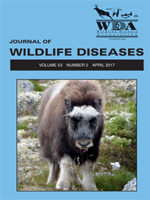We present microbiologic findings in harbor seal (phoca; Phoca vitulina) carcasses collected from the North Sea of Schleswig-Holstein, Germany, 1996–2014, and interpret results in relation to potential variations caused by phocine distemper virus and influenza A virus mass mortalities. We conducted microbiologic investigations on 2,124 tissue samples from lung, liver, kidney, spleen, intestine, and mesenteric lymph nodes from 549 dead harbor seals of the German North Sea. A large variety of bacteria, including potentially pathogenic species such as Bordetella bronchiseptica, Brucella spp., Clostridium perfringens, Escherichia coli, Erysipelothrix rhusiopathiae, β-hemolytic streptococci, and Staphylococcus aureus, were isolated. These bacteria were associated with bronchopneumonia, gastroenteritis, hepatitis, polyarthritis, nephritis, myositis, myocarditis, and septicemia. Bordetella bronchiseptica and Streptococcus equi subsp. zooepidemicus were significantly associated with the seal die-offs from phocine distemper in 2002 and influenza in 2014. Many bacteria were detected in tissues of dead harbor seals, of which E. coli, β-hemolytic streptococci, and Brucella spp. might be responsible for pathologic changes. Zoonotic bacteria such as Brucella spp. and E. rhusiopathiae are frequently isolated from harbor seals. Brucella spp. was less and Vibrio spp. more frequently found in summer. Erysipelothrix rhusiopathiae showed an almost regular 4-yr oscillating trend. We found C. perfringens less frequently and E. coli more frequently in harbor seals from St. Peter-Ording. Because zoonotic bacteria are regularly found, handling of dead and live harbor seal specimens should be conducted carefully to prevent transmission to humans. Further investigations are needed to understand microbiota changes in relation to increasing seal populations, reintroduction of rehabilitated seals to the wild, and increasing pressure from anthropogenic activities.
How to translate text using browser tools
1 April 2017
BACTERIAL MICROBIOTA IN HARBOR SEALS (PHOCA VITULINA) FROM THE NORTH SEA OF SCHLESWIG-HOLSTEIN, GERMANY, AROUND THE TIME OF MORBILLIVIRUS AND INFLUENZA EPIDEMICS
Ursula Siebert,
Marion Rademaker,
Sophie A. Ulrich,
Peter Wohlsein,
Katrin Ronnenberg,
Ellen Prenger-Berninghoff
ACCESS THE FULL ARTICLE

Journal of Wildlife Diseases
Vol. 53 • No. 2
April 2017
Vol. 53 • No. 2
April 2017
Bordetella bronchiseptica
Brucella spp.
Harbor Seal
influenza
microbiologic findings
North Sea
Phoca vitulina




